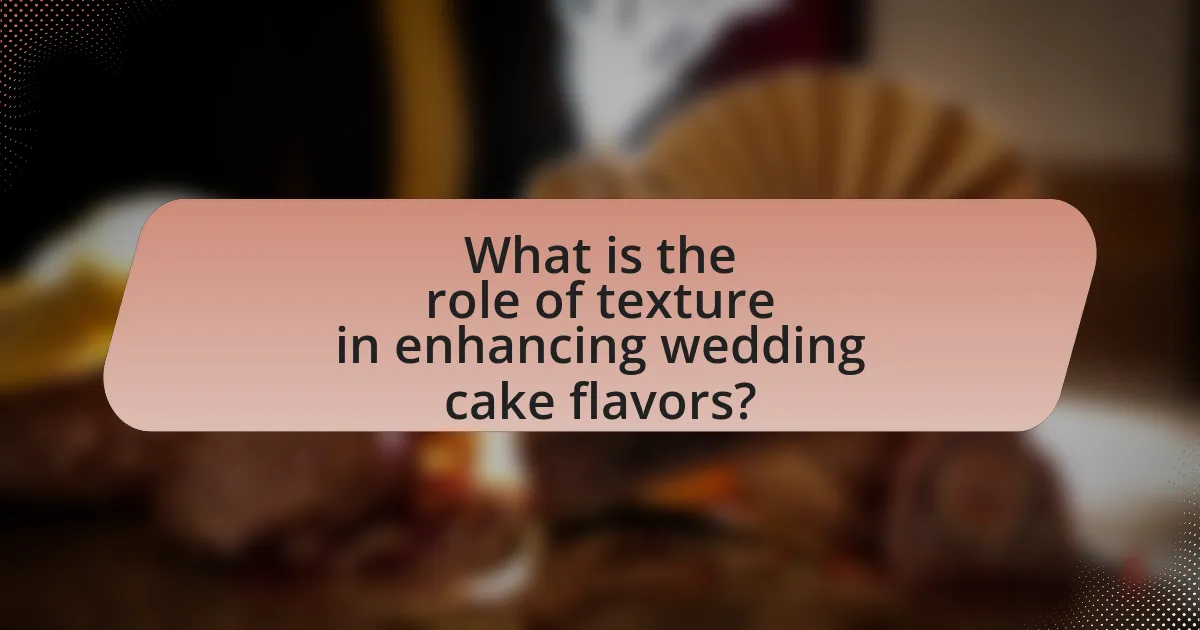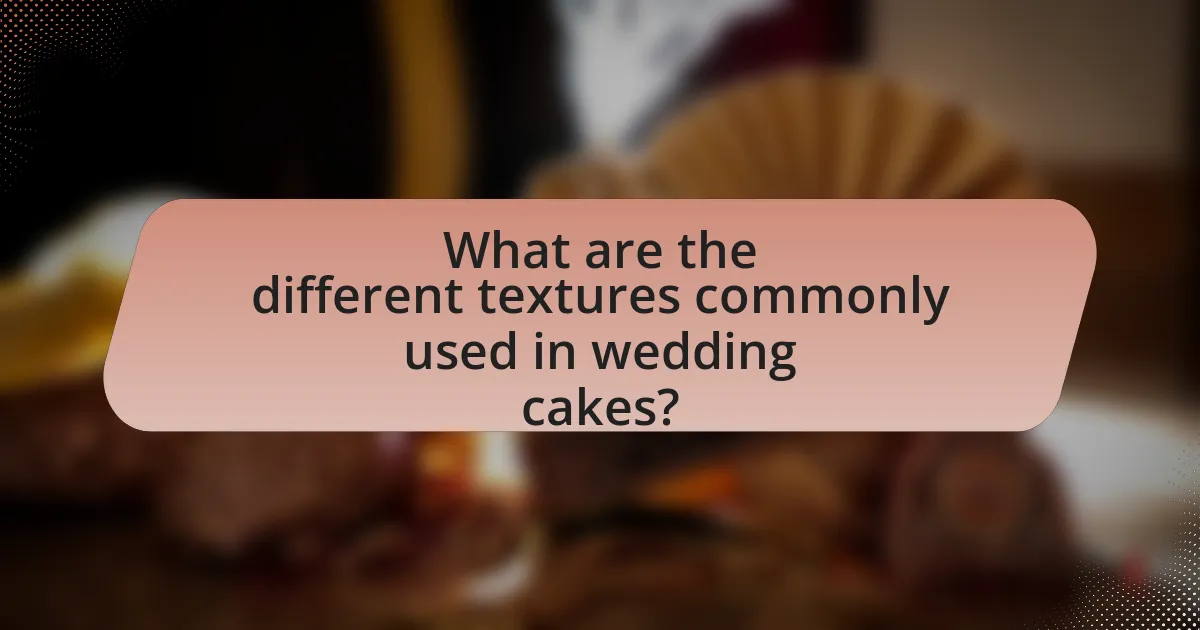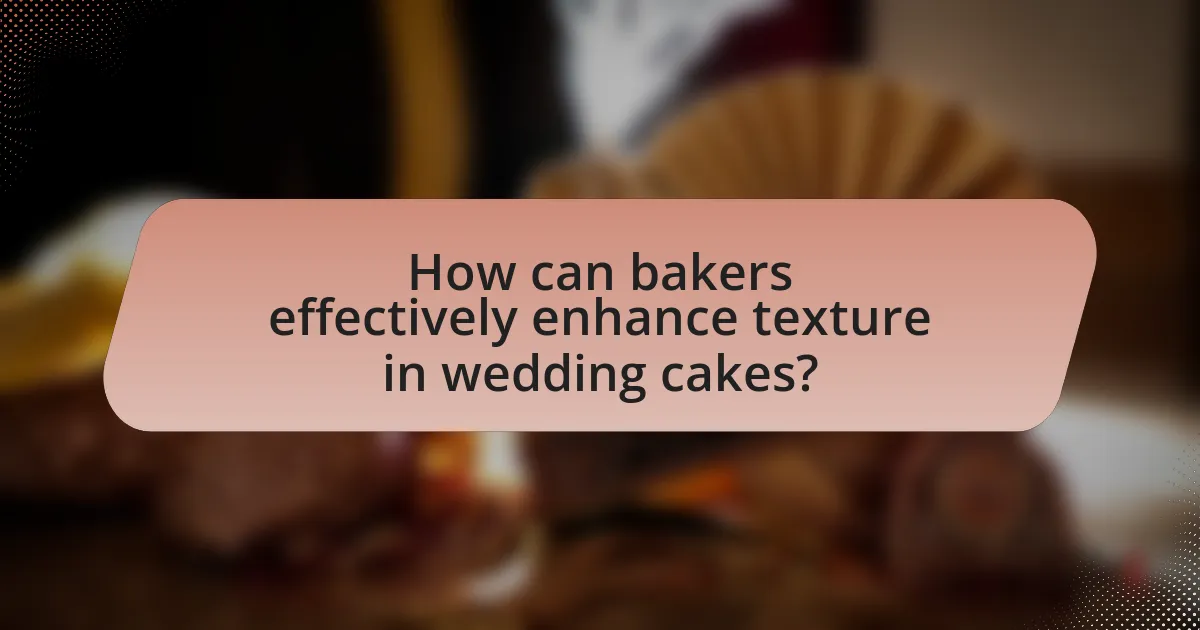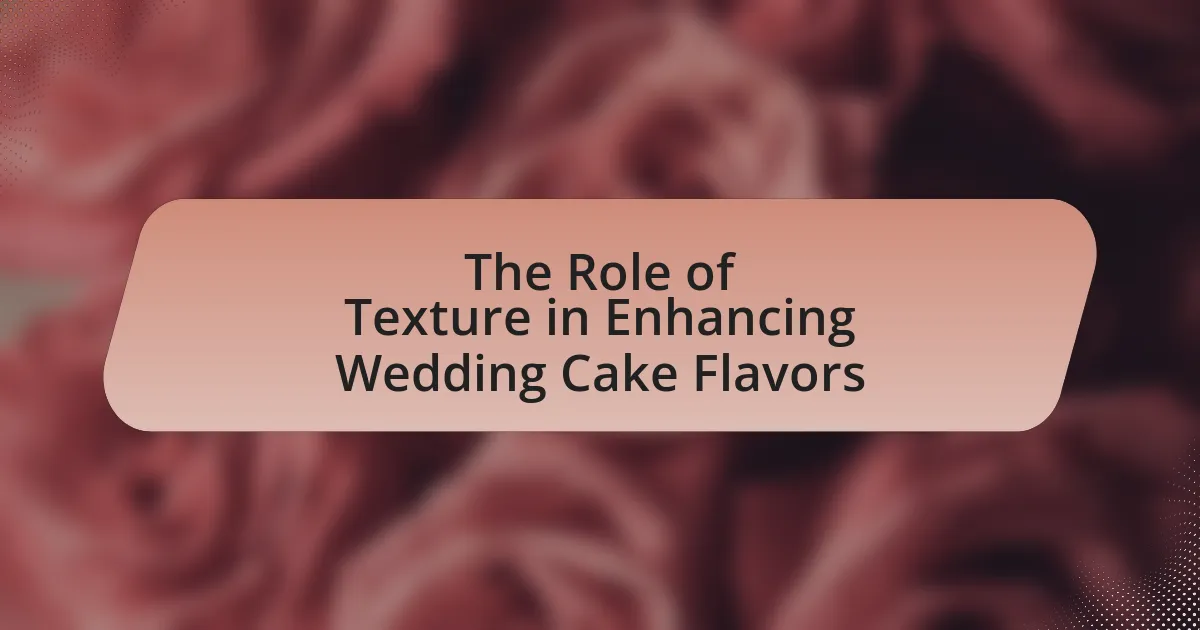The article focuses on the critical role of texture in enhancing the flavors of wedding cakes. It explores how various textures, such as moistness, crumb structure, and creaminess, influence taste perception and overall sensory experience. Key sections discuss the impact of texture on flavor release, the different types of textures commonly found in wedding cakes, and how fillings and frostings contribute to the cake’s texture. Additionally, the article highlights techniques bakers can use to achieve desired textures and common mistakes to avoid, emphasizing the importance of texture in creating a satisfying culinary experience during wedding celebrations.

What is the role of texture in enhancing wedding cake flavors?
Texture plays a crucial role in enhancing wedding cake flavors by influencing the overall sensory experience of taste. The interplay between different textures, such as moistness, crumb structure, and creaminess, can elevate the perception of flavor, making it more complex and enjoyable. For instance, a light and airy sponge cake can create a contrast with rich, creamy frosting, allowing the flavors to be more pronounced. Research indicates that texture affects taste perception; a study published in the journal “Food Quality and Preference” found that texture can significantly alter how flavors are perceived, with smoother textures often enhancing sweetness and richness. Thus, the careful consideration of texture in wedding cakes not only complements but also amplifies the flavors, leading to a more satisfying culinary experience.
How does texture influence the overall taste experience of wedding cakes?
Texture significantly influences the overall taste experience of wedding cakes by affecting mouthfeel, flavor release, and perception of sweetness. A cake’s texture, whether it is moist, crumbly, or dense, directly impacts how flavors are experienced; for instance, a moist cake allows for a more prolonged flavor release, enhancing the overall taste. Research indicates that texture can alter the perception of sweetness, with smoother textures often perceived as sweeter than grainy ones. This relationship between texture and taste is crucial in wedding cakes, where a harmonious balance of flavors and textures can elevate the dessert from merely sweet to a complex sensory experience.
What are the different types of textures found in wedding cakes?
Wedding cakes feature various textures that enhance their visual appeal and flavor experience. Common textures include smooth, which is often achieved with fondant or buttercream; rustic, characterized by a more natural, uneven finish; and textured, which can involve techniques like ruffling or piping to create intricate designs. Additionally, cakes may have a layered texture, combining different cake types or fillings, such as sponge, mousse, or ganache, to provide a contrast in mouthfeel. These textures not only contribute to the aesthetic but also influence the overall taste perception, making the cake more enjoyable.
How do various textures interact with flavors in wedding cakes?
Various textures in wedding cakes, such as moist, crumbly, and creamy, interact with flavors by enhancing the overall sensory experience. For instance, a moist cake can amplify flavors like vanilla or chocolate, making them more pronounced, while a crumbly texture can create a contrast that highlights richer flavors, such as buttercream or ganache. Additionally, creamy textures in frostings or fillings can provide a smooth mouthfeel that balances sweetness and acidity, allowing flavors to meld harmoniously. Research indicates that texture influences flavor perception; for example, a study published in the journal “Food Quality and Preference” found that texture significantly affects how flavors are experienced, with certain textures enhancing the perception of sweetness and richness in baked goods.
Why is texture important in the context of wedding cakes?
Texture is important in the context of wedding cakes because it significantly influences the overall sensory experience of the cake. A well-balanced texture enhances the flavors, making them more pronounced and enjoyable. For instance, a combination of moist cake layers with creamy frosting creates a pleasing contrast that elevates taste perception. Research indicates that texture can affect flavor release; for example, a study published in the journal “Food Quality and Preference” found that varying textures can alter the way flavors are perceived, leading to a more satisfying eating experience. Thus, the right texture not only complements the flavors but also contributes to the cake’s overall appeal and enjoyment during the wedding celebration.
What psychological effects does texture have on taste perception?
Texture significantly influences taste perception by altering the way flavors are experienced. Research indicates that the mouthfeel of food can enhance or diminish the perceived intensity of flavors; for example, creamy textures often amplify sweetness, while gritty textures can detract from it. A study published in the journal “Food Quality and Preference” by Spence et al. (2016) demonstrates that participants rated the same flavor as more intense when it was paired with a smooth texture compared to a rough one. This psychological effect occurs because texture interacts with sensory signals, leading to a more complex flavor experience.
How can texture contribute to the overall enjoyment of wedding cake?
Texture significantly enhances the overall enjoyment of wedding cake by influencing mouthfeel and flavor perception. A well-balanced texture, such as a moist crumb combined with a creamy frosting, creates a pleasurable eating experience that engages multiple senses. Research indicates that texture can affect taste intensity; for instance, a cake with a light, airy texture may enhance sweetness, while a denser cake can provide a richer flavor profile. Additionally, contrasting textures, such as a crunchy topping on a soft cake, can create a more dynamic and enjoyable experience, making each bite memorable.

What are the different textures commonly used in wedding cakes?
The different textures commonly used in wedding cakes include smooth, crumbly, dense, and airy. Smooth textures are often achieved through fondant or buttercream, providing a sleek appearance and a creamy mouthfeel. Crumbly textures, typically found in cakes like carrot or fruit cakes, add a rustic charm and enhance flavor complexity. Dense textures, characteristic of pound cakes or chocolate cakes, offer a rich and satisfying bite, while airy textures, seen in sponge or chiffon cakes, create a light and delicate experience. Each texture contributes uniquely to the overall flavor profile and enjoyment of the wedding cake.
How do moist and dry textures affect flavor perception?
Moist textures enhance flavor perception by allowing flavors to be more readily released and experienced on the palate, while dry textures can diminish flavor intensity due to reduced moisture content. Research indicates that moisture in food can facilitate the release of volatile compounds, which are crucial for flavor detection; for instance, a study published in the journal “Food Quality and Preference” by A. A. de Wijk and H. R. van der Lans found that moist foods are perceived as more flavorful compared to their dry counterparts. This is because moisture helps dissolve flavor compounds, making them more accessible to taste receptors. Conversely, dry textures may lead to a less intense flavor experience, as the lack of moisture can inhibit the release of these compounds, resulting in a muted taste perception.
What are the characteristics of moist wedding cakes?
Moist wedding cakes are characterized by their tender crumb, rich flavor, and a balanced moisture content that prevents dryness. The use of ingredients such as buttermilk, yogurt, or oil contributes to the cake’s moisture retention, enhancing its overall texture. Additionally, techniques like proper mixing and baking at the right temperature ensure that the cakes remain moist throughout. Studies indicate that cakes with higher fat content and the inclusion of syrups or fruit purees can significantly improve moisture levels, making them more enjoyable for consumption.
How can dry textures be balanced with flavors in wedding cakes?
To balance dry textures with flavors in wedding cakes, incorporating moist ingredients such as fruit purees, syrups, or creams is essential. These ingredients add moisture, enhancing the overall flavor profile and counteracting dryness. For instance, using a fruit puree can introduce both moisture and a complementary flavor, while syrups can provide sweetness and additional moisture. Additionally, flavor-rich fillings like ganache or custards can be layered within the cake, further balancing the texture. This approach is supported by culinary practices that emphasize the importance of moisture in achieving a harmonious balance between texture and flavor in baked goods.
What role do fillings and frostings play in cake texture?
Fillings and frostings significantly influence cake texture by adding moisture, creaminess, and structural contrast. Fillings, such as fruit preserves or custards, introduce a moist layer that can soften the cake, enhancing its overall tenderness. Frostings, whether buttercream or ganache, provide a rich, creamy exterior that can create a pleasing mouthfeel and balance the cake’s density. The combination of these elements contributes to a multi-dimensional texture, making the cake more enjoyable to eat. Studies in culinary science indicate that the interplay between cake and its fillings or frostings can elevate the sensory experience, leading to a more satisfying flavor profile.
How do different types of frostings enhance or alter cake texture?
Different types of frostings significantly enhance or alter cake texture by providing varying levels of moisture, density, and mouthfeel. For instance, buttercream frosting adds a rich, creamy texture that complements the cake’s softness, while cream cheese frosting introduces a tangy flavor and a denser consistency, which can make the cake feel more substantial. Ganache, made from chocolate and cream, creates a smooth, glossy finish that adds a luxurious texture, enhancing the overall eating experience. Additionally, whipped frosting, being lighter and airier, can make a cake feel less heavy, balancing out denser cake layers. These variations in frosting types not only influence the tactile sensation but also affect how flavors are perceived, making the choice of frosting crucial in the overall texture and flavor profile of wedding cakes.
What are some popular filling textures that complement wedding cakes?
Popular filling textures that complement wedding cakes include creamy, fruity, and nutty options. Creamy fillings, such as buttercream or ganache, provide a smooth and rich contrast to the cake’s texture, enhancing the overall flavor experience. Fruity fillings, like fruit preserves or curds, add a refreshing and tangy element that balances sweetness. Nutty fillings, such as praline or marzipan, introduce a crunchy texture that adds depth and complexity to the cake. These textures not only enhance the flavor profile but also create a more enjoyable eating experience, making them popular choices for wedding cakes.

How can bakers effectively enhance texture in wedding cakes?
Bakers can effectively enhance texture in wedding cakes by incorporating ingredients that create moisture and structure, such as buttermilk, sour cream, or yogurt, which contribute to a tender crumb. Additionally, using cake flour instead of all-purpose flour results in a finer texture due to its lower protein content, leading to a softer cake. The technique of creaming butter and sugar until light and fluffy also introduces air into the batter, improving the cake’s overall lightness. Furthermore, incorporating elements like fruit purees or nuts can add unique textures that complement the cake’s flavor profile. These methods are supported by baking science, which shows that the right balance of moisture and structure is crucial for achieving the desired texture in cakes.
What techniques can be used to achieve desired textures in wedding cakes?
To achieve desired textures in wedding cakes, bakers can utilize techniques such as layering, fondant application, and the use of different frosting styles. Layering involves stacking multiple cake layers with varying fillings, which can create a contrast in texture and enhance the overall mouthfeel. Fondant application provides a smooth, polished finish that can be shaped into intricate designs, contributing to both visual appeal and texture. Additionally, different frosting styles, such as buttercream, ganache, or whipped cream, can be employed to create varied textures on the cake surface, allowing for a more complex tasting experience. These techniques are widely recognized in the baking community for their effectiveness in enhancing the sensory qualities of wedding cakes.
How does the choice of ingredients impact cake texture?
The choice of ingredients significantly impacts cake texture by influencing moisture, density, and crumb structure. For instance, using all-purpose flour results in a denser cake compared to cake flour, which has a lower protein content and creates a lighter texture. Additionally, the type of fat used, such as butter versus oil, affects the cake’s moisture level; butter provides a rich flavor and a firmer texture, while oil yields a moist and tender crumb. Eggs also play a crucial role; they contribute to structure and stability, with more eggs leading to a richer texture. These ingredient choices directly correlate with the final cake’s mouthfeel and overall enjoyment, as supported by culinary science that emphasizes the importance of ingredient composition in baking.
What baking methods can enhance the texture of wedding cakes?
Baking methods that can enhance the texture of wedding cakes include the use of creaming, reverse creaming, and the incorporation of buttermilk or sour cream. The creaming method involves beating butter and sugar together until light and fluffy, which incorporates air and creates a tender crumb. Reverse creaming, where dry ingredients are mixed with butter before adding wet ingredients, results in a denser, moist cake with a fine crumb. Additionally, using buttermilk or sour cream adds acidity, which tenderizes gluten and contributes to a softer texture. These methods are supported by baking science, which shows that proper mixing techniques and ingredient choices directly influence the final cake’s texture.
What are some common mistakes to avoid when considering texture in wedding cakes?
Common mistakes to avoid when considering texture in wedding cakes include neglecting the balance between moistness and density, overlooking the impact of frosting and filling textures, and failing to consider the overall theme of the wedding. A cake that is too dense can be unappealing, while one that is overly moist may not hold its shape. Additionally, the texture of the frosting and filling should complement the cake; for example, pairing a light cake with a heavy frosting can create an imbalance. Finally, the chosen textures should align with the wedding’s aesthetic; a rustic wedding may benefit from a more textured cake, while a formal event might require a smoother finish.
How can improper texture affect the overall flavor of the cake?
Improper texture can significantly diminish the overall flavor of a cake by altering the way flavors are perceived and experienced. For instance, a cake that is too dry may lead to a lack of moisture, making flavors taste muted and less vibrant, while a cake that is overly dense can create a heavy mouthfeel that masks the subtleties of flavor. Research indicates that texture influences taste perception; a study published in the journal “Food Quality and Preference” found that texture can affect the release of flavor compounds, thereby impacting the overall flavor experience. Thus, achieving the correct texture is essential for enhancing the cake’s flavor profile.
What are the signs of a poorly textured wedding cake?
Signs of a poorly textured wedding cake include a dry, crumbly consistency, which indicates overbaking or insufficient moisture, and a dense, heavy feel, suggesting improper mixing or ingredient ratios. Additionally, an uneven crumb structure can reveal inadequate mixing or poor quality ingredients, while a gummy or sticky texture may point to underbaking or excessive moisture. These texture issues directly impact the overall flavor experience, as a well-textured cake enhances the enjoyment of its flavors.
What tips can help bakers create the perfect textured wedding cake?
To create the perfect textured wedding cake, bakers should focus on using high-quality ingredients, incorporating the right mixing techniques, and ensuring proper baking times and temperatures. High-quality ingredients, such as fresh eggs and premium flour, contribute to a better crumb structure, enhancing the cake’s texture. Mixing techniques, like creaming butter and sugar until light and fluffy, help incorporate air, resulting in a lighter cake. Additionally, baking at the correct temperature ensures even cooking, preventing dryness or undercooking, which can negatively affect texture. These practices are supported by baking science, which emphasizes the importance of ingredient quality and technique in achieving desirable cake textures.
